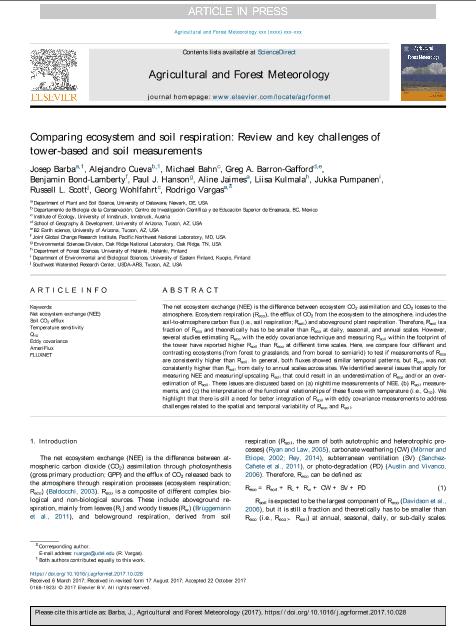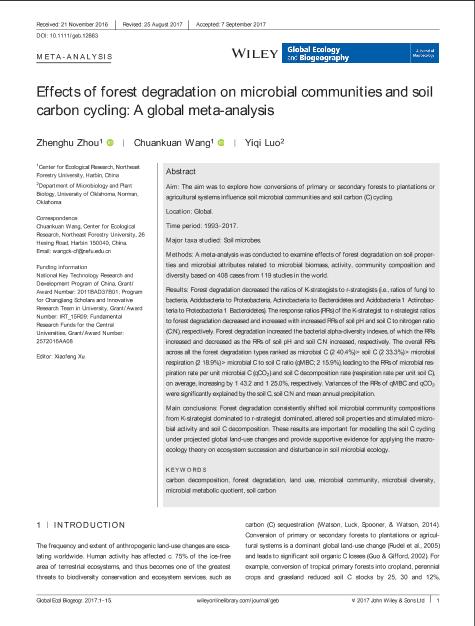Comparing ecosystem and soil respiration: Review and key challenges of tower-based and soil measurements

The net ecosystem exchange (NEE) is the difference between ecosystem CO2 assimilation and CO2 losses to the
atmosphere. Ecosystem respiration (Reco), the efflux of CO2 from the ecosystem to the atmosphere, includes the
soil-to-atmosphere carbon flux (i.e., soil respiration; Rsoil) and aboveground plant respiration. Therefore, Rsoil is a
fraction of Reco and theoretically has to be smaller than Reco at daily, seasonal, and annual scales. However,
several studies estimating Reco with the eddy covariance technique and measuring Rsoil within the footprint of
the tower have reported higher Rsoil than Reco at different time scales. Here, we compare four different and
contrasting ecosystems (from forest to grasslands, and from boreal to semiarid) to test if measurements of Reco
are consistently higher than Rsoil. In general, both fluxes showed similar temporal patterns, but Reco was not
consistently higher than Rsoil from daily to annual scales across sites. We identified several issues that apply for
measuring NEE and measuring/upscaling Rsoil that could result in an underestimation of Reco and/or an overestimation of Rsoil. These issues are discussed based on (a) nighttime measurements of NEE, (b) Rsoil measurements, and (c) the interpretation of the functional relationships of these fluxes with temperature (i.e., Q10). We
highlight that there is still a need for better integration of Rsoil with eddy covariance measurements to address
challenges related to the spatial and temporal variability of Reco and Rsoil.

Effects of forest degradation on microbial communities and soil carbon cycling: A global meta-analysis

Aim: The aim was to explore how conversions of primary or secondary forests to plantations or
agricultural systems influence soil microbial communities and soil carbon (C) cycling.
Location: Global.
Time period: 1993–2017.
Major taxa studied: Soil microbes.
Methods: A meta-analysis was conducted to examine effects of forest degradation on soil properties and microbial attributes related to microbial biomass, activity, community composition and
diversity based on 408 cases from 119 studies in the world.
Results: Forest degradation decreased the ratios of K-strategists to r-strategists (i.e., ratios of fungi to
bacteria, Acidobacteria to Proteobacteria, Actinobacteria to Bacteroidetes and Acidobacteria1 Actinobacteria to Proteobacteria 1 Bacteroidetes). The response ratios (RRs) of the K-strategist to r-strategist ratios
to forest degradation decreased and increased with increased RRs of soil pH and soil C to nitrogen ratio
(C:N), respectively. Forest degradation increased the bacterial alpha-diversity indexes, of which the RRs
increased and decreased as the RRs of soil pH and soil C:N increased, respectively. The overall RRs
across all the forest degradation types ranked as microbial C (240.4%)> soil C (233.3%)> microbial
respiration (218.9%)> microbial C to soil C ratio (qMBC; 215.9%), leading to the RRs of microbial respiration rate per unit microbial C (qCO2) and soil C decomposition rate (respiration rate per unit soil C),
on average, increasing by 143.2 and 125.0%, respectively. Variances of the RRs of qMBC and qCO2
were significantly explained by the soil C, soil C:N and mean annual precipitation.
Main conclusions: Forest degradation consistently shifted soil microbial community compositions
from K-strategist dominated to r-strategist dominated, altered soil properties and stimulated microbial activity and soil C decomposition. These results are important for modelling the soil C cycling
under projected global land-use changes and provide supportive evidence for applying the macroecology theory on ecosystem succession and disturbance in soil microbial ecology

Three years of soil respiration in a mature eucalypt woodland exposed to atmospheric CO2 enrichment

The rate of CO2 diffusion from soils to the
atmosphere (soil CO2 efflux, soil respiration; Rsoil)
reflects the integrated activity of roots and microbes
and is among the largest fluxes of the terrestrial global
C cycle. Most experiments have demonstrated that
Rsoil increases by 20–35% following the exposure of
an ecosystem to an atmosphere enriched in CO2 (i.e.,
eCO2), but such experiments have largely been
performed in young and N-limited ecosystems. Here,
we exposed a mature and phosphorus-limited eucalypt
woodland to eCO2 and measured Rsoil across three full
years with a combination of manual surveys and
automated measurements. We also implemented an
empirical model describing the dependence of Rsoil on
volumetric soil water content (h) and soil temperature
(Tsoil) to produce annual Rsoil flux estimates. Rsoil
varied strongly with Tsoil, h, and precipitation in
complex and interacting ways. The realized long-term
(weeks to years) temperature dependence (Q10) of Rsoil
increased from * 1.6 at low h up to * 3 at high h.
Additionally, Rsoil responded strongly and rapidly to
precipitation events in a manner that depended on the
conditions of h and Tsoil at the beginning of the rain
event; Rsoil increased by up to 300% within 30 min
when rain fell on dry soil that had not experience rain
in the preceding week, but Rsoil was rapidly reduced by
up to 70% when rain fell on wet soil, leading to
flooding. Repeated measures analysis of Rsoil observations over 3 years indicated no significant change in
response to CO2 enrichment (P = 0.7), and elevated
CO2 did not alter the dependence of Rsoil on Tsoil or h.
However, eCO2 increased Rsoil observations by *
10% under some constrained and moderate environmental conditions. Annual Rsoil flux sums estimated
with an empirical model were * 7% higher in eCO2
plots than in aCO2 plots, but this difference was not
statistically significant. The lack of a large eCO2 effect
on Rsoil is consistent with recent evidence that
aboveground net primary production was not stimulated by eCO2 in this ecosystem. The C budget of this
mature woodland may be less affected by eCO2 than
Responsible Editor: Egbert Matzner.
Electronic supplementary material The online version of
this article (https://doi.org/10.1007/s10533-018-0457-7) contains supplementary material, which is available to authorized
users.
J. E. Drake C. A. Macdonald M. G. Tjoelker
P. B. Reich B. K. Singh I. C. Anderson
D. S. Ellsworth
Hawkesbury Institute for the Environment, Western
Sydney University, Locked Bag 1797, Penrith,
NSW 2751, Australia
J. E. Drake (&)
Department of Forest and Natural Resources
Management, College of Environmental Science and
Forestry, State University of New York, 1 Forestry Dr,
Syracuse, NY, USA
e-mail: jedrake@esf.edu
P. B. Reich
Department of Forest Resources, University of Minnesota,
St. Paul, MN, USA
123
Biogeochemistry
https://doi.org/10.1007/s10533-018-0457-7the young N-limited ecosystems that have been
studied previously.

The temperature sensitivity (Q10) of soil respiration: controlling factors and spatial prediction at regional scale based on environmental soil classes
The temperature sensitivity of heterotrophic soil respiration is crucial for modeling carbon
dynamics but it is variable. Presently, however, most models employ a fixed value of 1.5 or
2.0 for the increase of soil respiration per 10°C increase in temperature (Q10). Here, we
identified the variability of Q10 at a regional scale (Rur catchment,
Germany/Belgium/Netherlands). We divided the study catchment into environmental soil
classes (ESC), which we define as unique combinations of land use, aggregated soil groups,
and texture. We took nine soil samples from each ESC (108 samples) and incubated them at
four soil moisture levels and five temperatures (5–25°C). We hypothesized that Q10
variability is controlled by soil organic carbon (SOC) degradability and soil moisture and that
ESC can be used as a widely available proxy for Q10, owing to differences in SOC
degradability. Measured Q10 values ranged from 1.2 to 2.8 and were correlated with
indicators of SOC degradability (e.g., pH, r=-0.52). The effect of soil moisture on Q10 was
variable: Q10 increased with moisture in croplands, but decreased in forests. The ESC
captured significant parts of Q10 variability under dry (R²=0.44) and intermediate (R²=0.36)
moisture conditions, where Q10 increased in the order cropland


Factors controlling soil microbial respiration during the growing season in a mature larch plantation in Northern Japa

Purpose Soil microbes contribute significantly to soil respiration (SR) in boreal forests; however, there is limited knowledge on microbial contributions from long field investigations. The objective of this study was to estimate soil microbial respiration, as well as its primary controlling factors, for a
period of three consecutive years.
Materials and methods A trenching method was used to distinguish soil microbial respiration (RMic) in a 55-year-old mature Japanese larch (Larix kaempferi) plantation in Northern
Japan; the soil in which developed originally from volcanic
soils containing pumice. We used a portable CO2 detection
system to measure the soil respiration rate during the growing
season. Environmental factors, soil physiochemical characteristics, and soil microbial biomass carbon and nitrogen (MBC
and MBN) were analyzed to explain the seasonal variations of
SR and RMic.
Results and discussion The results showed that the estimated
contribution of soil microbes to SR was 78, 62, and 55%
during the three successive years, respectively. Respiration
attributable to decomposition of aboveground litter contributed approximately 19% to SR. The major environmental factor
that affected RMic was soil temperature at 5 cm depth, which
accounted for more than 70% of the seasonal variation in RMic
observed. There were close relations among MBC, MBN, and
soil water content, but the soil water content showed no significant relation with RMic.
Conclusions The RMic to SR varied from 78 to 55% following
3 years of trenching treatments. Our results demonstrated the
important role of soil microbes on soil respiration in this larch
forest. Soil temperature was the major positive factor that influenced RMic, while soil water content had no significant effect.
Global warming will increase the loss of C into the atmosphere
by increasing the RMic, and could accelerate climate change.

Partitioning soil respiration: quantifying the artifacts of the trenching method

Total soil respiration (Rt) is a combination
of autotrophic (Ra) and heterotrophic respiration (Rh).
Root exclusion methods, such as soil trenching, are
often utilized to separate these components. This
method involves severing the rooting system surrounding a plot to remove the Ra component. However, soil trenching has potential limitations including
(1) reduced water uptake in trenched plots that
increases soil water content, which is one of the
environmental controllers of Rt in many ecosystems,
and (2) increased available carbon substrate for Rh
caused by recently severed dead roots. We present a
methodology that utilizes a bayesian modeling framework to quantify the magnitude of artifacts from a
large trenching manipulation experiment. Thus
methodology corrects Rh and Ra observations at daily
to seasonal time scales. This study finds that the
artifacts, due to recently severed roots, persist over a
2 years study period and the artifacts due to altered
soil moisture had the greatest impact during drought
conditions.

Partitioning of the net CO2 exchange using an automated chamber system reveals plant phenology as key control of production and respiration fluxes in a boreal peatland

The net ecosystem CO2 exchange (NEE) drives the carbon (C) sink-source strength of
northern peatlands. Since NEE represents a balance between various production and
respiration fluxes, accurate predictions of its response to global changes require an in depth
understanding of these underlying processes. Currently, however, detailed information of the
temporal dynamics as well as the separate biotic and abiotic controls of the NEE component
fluxes is lacking in peatland ecosystems. In this study, we address this knowledge gap by
using an automated chamber system established across natural and trenching-/vegetation
removal plots to partition NEE into its production (i.e. gross and net primary production; GPP
and NPP) and respiration (i.e. ecosystem, heterotrophic and autotrophic respiration; ER, Rh
and Ra) fluxes in a boreal peatland in northern Sweden. Our results showed that daily NEE
patterns were driven by GPP while variations in ER were governed by Ra rather than Rh.
Moreover, we observed pronounced seasonal shifts in the Ra/Rh and above-/belowground
NPP ratios throughout the main phenological phases. Generalized linear model analysis
revealed that the greenness index derived from digital images (as a proxy for plant
phenology) was the strongest control of NEE, GPP and NPP while explaining considerable
fractions also in the variations of ER and Ra. In addition, our data exposed greater
temperature sensitivity of NPP compared to Rh resulting in enhanced C sequestration with
increasing temperature. Overall, our study suggests that the temporal patterns in NEE and its
component fluxes are tightly coupled to vegetation dynamics in boreal peatlands and thus
challenges previous studies that commonly identify abiotic factors as key drivers. These
findings further emphasize the need for integrating detailed information on plant phenology
into process-based models to improve predictions of global change impacts on the peatland C
cycle

Different winter soil respiration between two mid-temperate plantation forests

Larch and Chinese pine plantation forests are important carbon (C) sinks in the temperate regions, especially in
China. However, their soil respiration in winter is still poorly studied. Here we explored the different microbial
characteristics and winter soil respiration in larch and Chinese pine plantation forests in northeastern China,
which has similar climate and basic soil characteristics. Results showed that both mean and cumulative winter
soil CO2 fluxes were significantly higher in Chinese pine forest (0.45 µmol m−2 s−1 and 46.39 g C m−2, respectively) than in larch forest (0.25 µmol m−2 s−1 and 25.92 g C m−2, respectively). Snow depth and inorganic
nitrogen (N) could not explain the differences in winter soil respiration between the two sites. Instead, Chinese
pine forest had higher soil microbial biomass, fungi abundance, F/B (ratio of fungi to bacteria), and extracellular
enzymatic activities (EEAs) than larch forest, which could lead to higher winter soil respiration in Chinese pine
forest than in larch forest. Our findings indicated that the thermal insulation effect of litter cover was important
to winter soil respiration, especially when the snow cover depth was less than 30 cm. Soil microbes played a
more important role in soil respiration than soil nutrient status and should be carefully considered for better
estimation of the C budget in different forest ecosystems. Although soil respiration was higher in Chinese pine
forest, soil organic C content was also higher, suggesting its better C sequestration capacity than larch forest.

Responses of soil respiration to soil management changes in an agropastoral ecotone in Inner Mongolia, China

Studying the responses of soil respiration (Rs) to soil management changes is critical
for enhancing our understanding of the global carbon cycle and has practical implications for grassland management. Therefore, the objectives of this study were (1) quantify daily and seasonal patterns of Rs, (2) evaluate the influence of abiotic factors on Rs,
and (3) detect the effects of soil management changes on Rs. We hypothesized that (1)
most of daily and seasonal variation in Rs could be explained by soil temperature (Ts)
and soil water content (S
w), (2) soil management changes could significantly affect Rs,
and (3) soil management changes affected Rs via the significant change in abiotic and
biotic factors. In situ R
s values were monitored in an agropastoral ecotone in Inner
Mongolia, China, during the growing seasons in 2009 (August to October) and 2010
(May to October). The soil management changes sequences included free grazing
grassland (FG), cropland (CL), grazing enclosure grassland (GE), and abandoned cultivated grassland (AC). During the growing season in 2010, cumulative Rs for FG, CL, GE,
and AC averaged 265.97, 344.74, 236.70, and 226.42 gC m−2 year−1, respectively.
The T
s and Sw significantly influenced Rs and explained 66%–86% of the variability in
daily Rs. Monthly mean temperature and precipitation explained 78%–96% of the variability in monthly Rs. The results clearly showed that Rs was increased by 29% with the
conversion of FG to CL and decreased by 35% and 11% with the conversion of CL to
AC and FG to GE. The factors impacting the change in Rs under different soil management changes sequences varied. Our results confirm the tested hypotheses. The increase in Q10 and litter biomass induced by conversion of FG to GE could lead to
increased R
s if the climate warming. We suggest that after proper natural restoration
period, grasslands should be utilized properly to decrease Rs.

Nitrogen fertilization stimulated soil heterotrophic but not autotrophic respiration in cropland soils: A greater role of organic over inorganic fertilizer

Nitrogen (N) enrichment may have considerable effects on soil carbon (C) fluxes. However, the responses of soil
respiration (Rs) and especially its heterotrophic (Rh) and autotrophic (Ra) components to N fertilization remain
controversial, and evidence on the impacts of N form and addition rate is lacking. We conducted a field experiment in a maize cropland in northeast China to investigate the responses of Rs, Rh, and Ra to different
inorganic (IN) and/or organic (ON) N fertilization regimes, including no N addition (CK) and five N-fertilized
treatments with a gradient ratio of IN to ON at 4:0 (IN4), 3:1 (IN3), 2:2 (IN2), 1:3 (IN1), and 0:4 (IN0). Annual Rs
was higher in the N-fertilized treatments than CK, but only significantly so for IN1. Fertilization increased Rh
from 118 to 123–149 g C m−2 with significant effects observed in all ON-fertilized treatments. However, fertilization did not affect Ra which varied at a range of 63–71 g C m−2. Rh was suppressed by excessive supply of
ammonium and nitrate which was more effectively increased by IN than ON fertilization, but always increased
with increasing extractable organic N and dissolved organic C which were higher in the treatments applied with
more ON. Accordingly, a greater role of ON over IN fertilization was found in stimulating Rh. Rs (2.76–3.81) and
Rh (2.67–3.28) had higher Q10 values than Ra (1.51–2.05). Application of N fertilizer, especially IN, enhanced
the Q10 value of Ra, but decreased those of Rs and Rh. Unexpectedly, grain yield and aboveground biomass were
reduced by IN fertilization, but increased with increasing ON fertilizer application rate. Overall, our findings
highlight the significance of the form and addition rate of N fertilizer on soil C cycling and its feedback to climate
change under N enrichment.

{{item.title}}
![]()
{{item.summary}}



